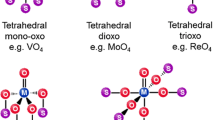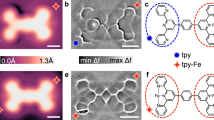Abstract
Although tunneling spectroscopy has been applied heretofore to only a limited extent in the investigation of homogeneous cluster compounds supported on oxide surfaces, it is quite possible that it will prove to be one of the more valuable techniques that can be used to elucidate the structure and catalytic reactivity of this important class of catalysts. The principles of tunneling spectroscopy have been described in Chapter 1 of this book as well as in the previous review articles.(1–5) Examples of the use of tunneling spectroscopy to investigate the catalytic properties of metal crystallites supported on oxide surfaces have been described in previous review articles,(1–5) and, in particular, in Chapter 13 of this text. This application is closely related to the study of supported homogeneous cluster compounds. In the former case, one is concerned with aggregates of reduced metallic atoms attached to an oxide “support,” while in the latter case, the topic of this chapter, one is concerned with the attachment and catalytic reactivity of cluster compounds (which may or may not have lost one or more of their ligands) “supported” on an oxide surface.
Work supported by the National Science Foundation under grant No. CPE-8024597.
Access this chapter
Tax calculation will be finalised at checkout
Purchases are for personal use only
Preview
Unable to display preview. Download preview PDF.
Similar content being viewed by others
References
P. K. Hansma, Inelastic electron tunneling, Phys. Rep. 30C, 145–206 (1977).
W. H. Weinberg, Inelastic electron tunneling spectroscopy: A probe of the vibrational structure of surface species, Ann. Rev. Phys. Chem. 29, 115–139 (1978).
P. K. Hansma and J. Kirtley, Recent advances in inelastic electron tunneling spectroscopy, Acc. Chem. Res. 11, 440–445 (1978).
Inelastic Electron Tunneling Spectroscopy (T. Wolfram, ed.), Springer-Verlag, New York (1978).
R. M. Kroeker and P. K. Hansma,Tunneling spectroscopy for the study of adsorption and reaction on model catalysts, Catal. Rev. 23, 553–603 (1981).
W. M. Bowser and W. H. Weinberg, The nature of the oxide barrier in inelastic electron tunneling spectroscopy, Surf. Sci. 64, 377–392 (1977).
H. E. Evans, W. M. Bowser, and W. H. Weinberg, An XPS investigation of alumina thin films utilized in inelastic electron tunneling spectroscopy, Appl. Surf. Sci. 5, 258–274 (1980).
P. K. Hansma, D. A. Hickson, and J. A. Schwarz, Chemisorption and catalysis on oxidized aluminum metal, J. Catal. 48, 237–242 (1977).
H. E. Evans and W. H. Weinberg, Inelastic electron tunneling spectroscopy of zirconium tetraborohydride supported on aluminum oxide, J. Am. Chem. Soc. 102, 872–873 (1980).
H. E. Evans and W. H. Weinberg, Synthesis and catalytic reactions of Zr(BH4)4 on Al203 characterized by inelastic electron tunneling spectroscopy, J. Vac. Sci. Technol. 17, 47–48 (1980).
H. E. Evans and W. H. Weinberg, A vibrational study of zirconium tetraborohydride supported on aluminum oxide. I. Interactions with deuterium, deuterium oxide and water vapor, J. Am. Chem. Soc. 102, 2548–2553 (1980).
H. E. Evans and W. H. Weinberg, A vibrational study of zirconium tetraborohydride supported on aluminum oxide. 2. Interactions with ethylene, propylene and acetylene, J. Am. Chem. Soc. 102, 2554–2558 (1980).
L. Forester and W. H. Weinberg, A vibrational study of Zr(BH4)4 supported on alumina: Interactions with cyclohexene, 1,3-cyclohexadiene and benzene, J. Vac. Sci. Technol. 18, 600–601 (1981).
W. H. Weinberg, W. M. Bowser, and H. E. Evans, Reduced metallic clusters and homogeneous cluster compounds “supported” on aluminum oxide as studied by inelastic electron tunneling spectroscopy, Surf. Sci. 106, 489–497 (1981).
W. M. Bowser and W. H. Weinberg, An inelastic electron tunneling spectroscopic study of Ru3(CO)12 adsorbed on an aluminum oxide surface, J. Am. Chem. Soc. 102, 4720–4724 (1980).
W. M. Bowser and W. H. Weinberg, An inelastic electron tunneling spectroscopic study of the interaction of [RhCl(CO)2]2 with an aluminum oxide surface, J. Am. Chem. Soc. 103, 1453–1458 (1981).
S. D. Williams, M. K. Dickson, D. M. Roundhill, and K. W. Hipps, The vibrational spectrum of the surface species obtained by solution doping of alumina with Fe3(CO)12 as studied by inelastic electron tunneling spectroscopy, Washington State University (unpublished report).
V. A. Zakharov and Yu. I. Yermakov, Supported organometallic catalysts of olefin polymerization, Catal. Rev. 19, 67–103 (1979).
W. M. Bowser and W. H. Weinberg, Sample heating and simultaneous temperature measurement in inelastic electron tunneling spectroscopy, Rev. Sci. Instrum. 47. 583–586 (1976).
U. Mazur and K. W. Hipps, An inelastic electron tunneling spectroscopy study of the adsorption of NCS-, OCN- and CN- from water solution on Al2O3, J. Phys. Chem. 83. 2773–2777 (1979).
T. J. Marks, W. J. Kennelly, J. R. Kolb, and L. A. Shimp, Structure and dynamics in metal tetrahydroborates. II. Vibrational spectra and structures of some transition metal actinide tetrahydroborates. Inorg. Chem. 11. 2540–2546 (1972).
B. D. James and M. G. H. Wallbridge, Metal tetrahydroborates. Prog. Inorg. Chem. 11, 99–231 (1970).
T. J. Marks and J. R. Kolb, Covalent transition metal, lanthanide. and actinide tetrahydroborate complexes. Chem. Rev. 77, 263–293 (1977).
T. Matsuda and H. Kawashima, An infrared study of hydroboration of lower olefins with dihorane on y-Al2O3. J. Catal. 49, 141–149 (1977).
B. E. Smith, B. D. James, and J. A. Dilts, Bis(tetrahydroborate)bis (cyclopentadienyl)zirconium(IV): A synthetic, thermoanalytical and vibrational spectroscopic study, J. Inorg. Nucl. Chem. 38, 1973–1978 (1976).
H. E. Flotow and D. W. Osborne, Heat capacities and thermodynamic functions of ZrH2 and ZrD2 from 5 to 350°K and the hydrogen vibrational frequency in ZrH2, J. Chem. Phys. 34, 1418–1425 (1961).
B. E. Smith, H. F. Shurwell, and B. D. James, Molecular vibrations of zirconium(IV) tetrahydroborate, a compound containing triple hydrogen bridges. J. Chem. Soc. Dalton Trans. 1978, 710–722.
D. G. H. Ballard, Transition metal alkyl compounds as polymerization catalysts, J. Poh •m. Sci. 13, 2191–2212 (1975).
N. L. Albert, W. E. Keiser, and H. A. Szymanski, Theory and Practice of Infrared Spectroscopy, Plenum Press, New York (1970).
R. T. Conley, Infrared Spectroscopy, Allyn and Bacon, Boston (1972).
S. Krimm, C. Y. Liang, and G. B. B. M. Sutherland, Infrared spectra of high polymers. II. Polyethylene, J. Chem. Phi’s. 25, 549–562 (1956).
J. R. Nielsen and A. H. Woollen. Vibrational spectra of olyethylenes and related substances, J. Chem. Phys. 26, 1391–1400 (1957).
D. O. Hummel, Infrared Spectra of Polymers. Polymer Rev. 14, 8–97 (1966).
K. Abe and K. Yanagisawa, Infrared spectra of melted polypropylene films, J. Polym. Sci. 36, 536–539 (1959).
J. P. Luongo, Infrared study of polypropylene, J. Appl. Polym. Sci. 3, 302–309 (1960).
C. R. Ficker, Jr., M. Ozaki, A. J. Heeger, and A. G. MacDiarmid, Donor and acceptor states in lightly doped polyacetylene, (CH),, Phys. Rev. B 19, 4140–4148 (1979).
L. Forester, unpublished results.
P. C. Wailes, H. Weingold, and A. P. Bell, Hydrido complexes of zirconium(IV): Reactions with olefins, J. Organomet. Chem. 43, C32 - C34 (1972).
M. R. Churchill, F. J. Hollander, and J. P. Hutchinson, An accurate redetermination of the structure of triruthenium dodecacarbonyl, Ru3(CO)12, Inorg. Chem. 16, 2655–2659 (1977).
W. M. Bowser, PhD thesis, California Institute of Technology (1980).
J. R. Anderson, P. S. Elmes, R. F. Howe, and D. E. Mainwaring, Preparation of some supported metallic catalysts from metallic cluster carbonyls, J. Catal. 50, 508–518 (1977).
J. Robertson and G. Webb, Catalysis by supported group VIII metal compounds. I. The interaction of n-butane with hydrogen over silica-supported ruthenium carbonyl catalysts, Proc. R. Soc. London Ser. A 341, 383–398 (1974).
C. O. Quicksall and T. G. Spiro, Raman frequencies of metal cluster compounds: 0s3(CO)12 and Ru3(CO)12, Inorg. Chem. 7. 2365–2369 (1968).
J. R. Kirtley and P. K. Hansma, Vibrational mode shifts in inelastic electron tunneling spectroscopy: Effects due to superconductivity and surface interactions, Phis. Rey. B 13, 2910–2917 (1976).
R. M. Kroeker, W. C. Kaska, and P. K. Hansma, How carbon monoxide bonds to alumina-supported rhodium particles: tunneling measurements with isotopes, J. Catal. 57, 72–79 (1979).
J. Klein, A. Léger, S. DeCheveigné, C. Guinet, M. Belin, and D. Defourneau, An inelastic electron tunneling spectroscopy study of the adsorption of CO on Rh, Surf. Sci. 82 L288 - L292 (1979).
H. E. Evans, W. M. Bowser, and W. H. Weinberg, The adsorption of ethanol on silver clusters supported on alumina, Surf. Sci. 85, L497 - L502 (1979).
C. W. Garland and J. R. Wilt, Infrared spectra and dipole moments of Rh2(CO)4C12 and Rh2(CO)4Br2, J. Chem. Phys. 36, 1094–1095 (1962).
L. F. Dahl, C. Martell, and D. L. Wampler, Structure of and metal-metal bonding in Rh(CO)2C1, J. Am. Chem. Soc. 83, 1761–1762 (1961).
A. C. Yang and C. W. Garland, Infrared studies of carbon monoxide chemisorbed on rhodium, J. Phys. Chem. 61, 1504–1512 (1957).
H. Arai and H. Tominga, An infrared study of nitric oxide adsorbed on a rhodium-alumina catalyst. J. Catal. 43, 131–142 (1976).
J. T. Yates, Jr., T. M. Duncan, S. D. Worley, and R. W. Vaughan, Infrared spectra of chemisorbed CO on Rh, J. Chem. Phys. 70, 1219–1224 (1979).
D. J. C. Yates, L. L. Murrell, and E. B. Prestridge, Ultradispersed rhodium rafts: Their existence and topology, J. Catal. 57, 41–63 (1979).
G. C. Smith, T. P. Chojnacki, S. R. Dasgupta, K. Iwatate, and K. L. Watters. Surface-supported metal cluster carbonyls. I. Decarbonylation and aggregation reactions of rhodium clusters on alumina, Inorgan. Chem. 14, 1419–1421 (1975).
P. K. Hansma, W. C. Kaska, and R. M. Laine, Inelastic electron tunneling spectroscopy of carbon monoxide chemisorbed on alumina-supported transition metals, J. Am. Cheat. Soc. 98, 6064–6065 (1976).
G. Carturan and G. Strukul. Atomically dispersed palladium as a borderline case between heterogeneous and homogeneous hydrogenation of olefins. J. Catal. 57, 516–521 (1979).
J. F. Hamilton and R. C. Baetzold, Catalysis by small metal clusters, Science. 205, 1213–1220 (1979).
J. Lewis, A. R. Manning, J. R. Miller, and J. M. Wilson, Chemistry of polynuclear compounds. VII. The mass spectra of some polynuclear metal carbonyl complexes. J. Chem. Soc. A 1966, 1663–1670.
R. B. King, Some novel features in the mass spectra of polynuclear metal carbonyl derivatives, J. Am. Chem. Soc. 88, 2075–2077 (1966).
J. Lewis and B. F. G. Johnson, Mass spectra of some organometallic molecules. Acc. Chem. Res. 1, 245–256 (1968).
M. I. Bruce and F. G. A. Stone, Dodecacarbonyltriruthenium, Angew. Chem. Int. Ed. Engl. 7, 427–432 (1968).
C. H. Wei and L. F. Dahl, Triiron dodecacarbonyl: An analysis of its stereochemistry, J. Am. Chem. Soc. 91, 1351–1361 (1969).
A. Brenner and D. A. Hucul, Catalysts of supported iron derived from molecular complexes containing one, two, and three iron atoms, Inorg. Chem. 18, 2836–2840 (1979).
F. Hugues, A. K. Smith, Y. Ben Taarit, J. M. Basset, D. Commereuc, and Y. Chauvin, Surface-supported metal carbonyl clusters: Formation of [HFe3(CO)11]- by interaction of Fe3(CO)12 and Fe(CO)5 with alumina and magnesia, J. Chem. Soc. Chem. Commun. 1980, 68–70.
D. Commereuc, Y. Chauvin, F. Hugues, J. M. Basset, and D. Olivier, Catalytic synthesis of low molecular weight olefins from CO and H2 with Fe(CO)5, Fe3(CO)12 and [HFe3(CO)11]supported on inorganic oxides, J. Chem. Soc. Chem. Commun. 1980, 154–155.
J. S. Kristoff and D. F. Shriver, Adduct formation and carbonyl rearrangement of polynuclear carbonyls in the presence of group VIII halides, Inorg. Chem. 13, 499–506 (1974).
D. Ballivct-Tkatchcnko, G. Conduricr, H. Mozzanega, and I. Tkatchenko, in Fundamental Research in Homogeneous Catalysis ( M. Tsutsui, ed.), p. 257, Plenum Press, New York (1979).
M. Bigorgne, Étude spectroscopique Raman et infrarouge de Fe(CO)5, Fe(CO)4 L, et trans-Fe(CO)3 L2 (l, = PMe3, AsMe3, SbMe3). I. Attribution des bandes de Fe(CO)5, J. Organomet. Chem. 24, 211–229 (1970).
I. S. Butler, S. Kishner, and K. R. Plowman, Vibrational spectra of solid tri-µ-carbonyl(hexacarbonyl)di-iron(0), Fe2(CO)9, J. Mol. Struct. 43, 9–15 (1978).
N. Davies, M. G. H. Wallbridge, B. E. Smith, and B. D. James, Vibrational spectra of zirconium tetrahydroborate and related molecules, J. Chem. Soc. Dalton Trans. 1973, 162–165.
Author information
Authors and Affiliations
Editor information
Editors and Affiliations
Rights and permissions
Copyright information
© 1982 Plenum Press, New York
About this chapter
Cite this chapter
Weinberg, W.H. (1982). The Structure and Catalytic Reactivity of Supported Homogeneous Cluster Compounds. In: Hansma, P.K. (eds) Tunneling Spectroscopy. Springer, Boston, MA. https://doi.org/10.1007/978-1-4684-1152-2_12
Download citation
DOI: https://doi.org/10.1007/978-1-4684-1152-2_12
Publisher Name: Springer, Boston, MA
Print ISBN: 978-1-4684-1154-6
Online ISBN: 978-1-4684-1152-2
eBook Packages: Springer Book Archive




